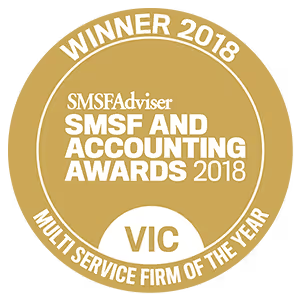Setting up a self-managed super fund (SMSF) can be an excellent way to take control of your financial future and tailor your retirement investments to meet your specific goals. But with that freedom comes complexity — and if you get it wrong, you could face costly mistakes and compliance issues.
We’re award-winning SMSF accountants with years of experience helping Australians create effective, compliant SMSFs that work for them. Our team has guided countless clients through the SMSF setup process, ensuring their funds are structured to provide maximum value while meeting all legal requirements.
In this guide, we’ll walk you through everything you need to know about setting up a self-managed super fund in Australia, including:
- What an SMSF is and why you might want to set one up.
- The step-by-step process for setting up an SMSF, including timelines and costs.
- How much money you need to make an SMSF worthwhile.
- Common mistakes to avoid when setting up your SMSF.
- Why expert advice is essential for setting up your SMSF the right way.
If you’re thinking about setting up an SMSF, we can help you get it right from the start.
[smsf_awards][/smsf_awards]
What is an SMSF?
A Self-Managed Super Fund (SMSF) is a private superannuation fund that you manage yourself, rather than relying on retail or industry super funds. With an SMSF, you have complete control over your investment strategy, allowing you to tailor your investments to meet your specific retirement goals.
Unlike traditional super funds, an SMSF can hold a wide range of investments, including:
- Shares
- Property
- Precious metals
- Collectibles
This flexibility allows you to build a diversified portfolio that suits your unique financial situation. As the trustee of your SMSF, you make all the investment decisions and are responsible for complying with superannuation and tax laws.
The appeal of an SMSF lies in the control it offers. You’re not restricted by standard investment options — you can actively manage your wealth, choosing investments that align perfectly with your financial goals.
But it’s not just about control. It’s also about responsibility. You need to ensure your SMSF operates effectively and remains compliant to avoid hefty penalties.
Why set up an SMSF?
Setting up an SMSF offers several benefits, but it’s not the right choice for everyone. If you have a substantial super balance — generally above $500,000 — an SMSF can provide greater control over your retirement savings and help you create a more tailored investment strategy.
The main reasons people set up an SMSF are:
- Investment Control:
- You have the flexibility to make investment choices that suit your financial goals.
- Whether it’s investing in direct property, shares, or other assets, you can build a portfolio that suits your specific needs.
- You can also adjust your investment strategy over time as your circumstances and preferences change.
- Potential Cost Savings:
- Once your balance reaches around $500,000 or more, the fees associated with running an SMSF can become more cost-effective compared to retail or industry super funds.
- However, balances below $250,000 can result in disproportionately high fees, making SMSFs less attractive for those with smaller balances.
- Estate Planning:
- An SMSF gives you greater control over how your superannuation benefits are distributed when you pass away.
- This can allow for more sophisticated financial planning strategies that ensure your wealth is distributed according to your intentions.
But setting up an SMSF is not just about having a substantial balance. It’s about ensuring your investment approach suits your financial situation, goals, and willingness to manage your own fund.
[feature_link]Wondering where to invest your SMSF funds? Explore the best investment options to help you achieve your retirement goals.[/feature_link]
What’s involved in setting up an SMSF?
Setting up a Self-Managed Super Fund (SMSF) involves several key steps. Here’s a breakdown of the typical actions you’ll need to take, along with the expected time frames for each.
Step 1: Deciding if an SMSF is right for you
Time: 1 week
The first step is to consult a licensed financial adviser. They’ll assess your financial situation, investment goals, and explain your superannuation options. With their support, you can determine if an SMSF is the right choice for you.
You’ll also need to work with your adviser to establish:
- Your insurance strategy.
- Your investment strategy.
Step 2: Preparing a Statement of Advice (SOA)
Time: 2 weeks
Your adviser will prepare an SOA, officially documenting whether an SMSF is suitable for you. Once you sign off on this advice, you can begin setting up your SMSF.
This stage also includes:
Insurance considerations (2–3 days):
- Determine what type of insurance you need and the necessary levels of cover.
- Decide whether your insurance is held inside or outside your SMSF.
Preparing your SMSF investment strategy (1 week):
- Expected levels of risk and returns.
- Diversification of investments.
- Liquidity requirements.
- Ability to meet payment obligations.
Your strategy must demonstrate you’ve properly considered how to manage your investments.
[feature_link]Curious about getting your Statement of Advice right for an SMSF? Discover how a tailored SOA ensures your SMSF is set up properly and meets compliance requirements.[/feature_link]
Step 3: Setting up your fund and trust deed
Time: 2 weeks
Your adviser will create a trust deed to establish your SMSF. This document outlines the rules governing your fund and provides the legal framework to operate it.
Actions to complete:
- Choose a name for your SMSF (e.g., The John Smith Superannuation Fund).
- Decide if you need to create a company to act as the trustee of your SMSF.
- Register an ABN for your fund.
- If applicable, register an ACN with ASIC for the trustee company.
Step 4: Registering your fund with the ATO
Time: 3 days
Your SMSF needs to be registered with the ATO. You’ll also need to create a Tax File Number (TFN) for your SMSF, which is separate from your personal TFN. This TFN is required to lodge your SMSF’s annual tax returns.
Step 5: Setting up your bank account and rolling over your super
Time: 1 week
Once your SMSF has a trust deed, TFN, ABN, and ACN, you can open a bank account. Make sure to choose a bank that offers fee-free accounts.
From there, you can:
- Rollover your existing super from other funds by completing a rollover form from your current super funds.
- Be aware that SMSF setup times can vary depending on how efficient your existing super funds are at processing rollovers.
Important for sole traders: If you plan to claim the current financial year’s personal super contributions as a tax deduction, you must submit a notice to claim to your existing super fund before rolling over.
Step 6: Getting online access to view your fund
Time: 1 day
Contact your bank to set up online banking for your SMSF account. Most banks offer immediate online access once your account is set up.
Step 7: Setting up broking accounts
Time: 1 day
If you’re investing in shares, you’ll need to set up a broking account in the name of your SMSF. The same applies to managed funds or term deposits.
Step 8: Investing your money
Time: 3 days
Once your accounts are established, you can begin making investments in the name of your SMSF. Ensure all income generated from these investments is directed to your SMSF bank account.
[free_strategy_session]
Free SMSF Strategy Session
Take control of your retirement savings with a free 90-minute SMSF strategy session.
- Understand your financial goals and whether an SMSF suits your needs.
- Receive a tailored report to guide your SMSF setup and ensure compliance.
- Plan your next steps with clear, actionable advice.
[/free_strategy_session]
The minimum balance you need for an SMSF
When speaking with our clients, the absolute minimum viable amount we recommend to start an SMSF is $250,000.
However, it's not just a matter of getting to this minimum amount, and then an SMSF becomes appropriate for you. There are a number of other factors that need to be considered as part of a choice in setting up a SMSF.
- Are you interested in running your own super fund?
- Do you have the skills and ability to do this?
- Are you getting the right advice to do this?
We wouldn’t recommend an SMSF for anyone with less than $250,000 in their super. This can be a combined balance, say between a husband and wife, or two partners.
In some circumstances, for balances between $250,000 and $500,000 we may still recommend that an SMSF is not suitable.
Ultimately, it depends on your personal circumstances and how much effort you’re prepared to put into managing your fund

How much money do I need to start my SMSF?
Ideally, we like to see combined balances in excess of $500,000 before we think an SMSF can really be of benefit to you.
$250k vs $500k — what’s the difference?
The main disadvantage of having a superfund balance of $250,000 or less is the associated fees. You will likely be paying higher comparative fees in an SMSF than what you would pay in an industry or retail fund.
In general, in industry and retail funds you can expect to pay between 0.6% to 1.5% in annual fees on the balance of your super. So for a balance of $250,000, you might pay between $1,500 to $3,750 per year.
According to ATO statistics, SMSFs with less than $200,000 are likely to be paying over 6% of their entire fund balance in fees. So for an SMSF, you would need to budget at minimum $5,000 per year to cover your fees. This includes accounting, investment advice, an annual audit, and the ATO levy.
SMSF fees are proportional, so for SMSFs over $500,000, this percentage drops to 1.5% of their entire fund. Therefore, it begins to make a lot more sense to start an SMSF with a balance closer to $500,000.
The more you have, the less you pay
The good news is that this means your overall comparative costs will go down over time. The Productivity Commission’s Superannuation: Assessing Efficiency and Competitiveness Report confirms this. It notes that SMSFs that have been operational for over five years typically have lower overall costs than newly established SMSFs.
But again, it really depends on your needs, and determination. If you have a balance in excess of $250,000 and you’re set on having an SMSF, then it’s certainly possible to set one up. You just need to ensure you’re getting the right advice.

How long does it take to set up an SMSF?
Setting up a Self-Managed Super Fund (SMSF) can be a complex process, and the time it takes will depend on your preparation and the professional support you have. While every SMSF is unique, the setup process generally takes between 4 to 6 weeks from start to finish. Here’s a step-by-step breakdown of the typical timeline:
[table]
[thead]
[tr][th]Task[/th][th]Estimated Time[/th][/tr]
[/thead]
[tbody]
[tr][td]Deciding if an SMSF is the right structure[/td][td]1 week[/td][/tr]
[tr][td]Preparing a Statement of Advice (SOA)[/td][td]2 weeks[/td][/tr]
[tr][td]Setting up your fund and the trust deed[/td][td]2 weeks[/td][/tr]
[tr][td]Registering your fund with the ATO[/td][td]3 days[/td][/tr]
[tr][td]Setting up your bank account and rolling over super[/td][td]1 week[/td][/tr]
[tr][td]Getting online access to view your fund[/td][td]1 day[/td][/tr]
[tr][td]Setting up broking accounts[/td][td]1 day[/td][/tr]
[tr][td]Investing your money[/td][td]3 days[/td][/tr]
[tr][td]Total estimated time[/td][td]4 – 6 weeks[/td][/tr]
[/tbody]
[/table]
The actual setup time may vary depending on your financial adviser’s efficiency, how quickly you complete the required paperwork, and the responsiveness of your existing super funds during the rollover process.
Why does it take so long to set up an SMSF?
Establishing an SMSF involves multiple steps, including creating a trust deed, registering your fund with the ATO, and ensuring compliance with superannuation laws. Since an SMSF is a lifelong commitment, taking the time to get it right from the start is crucial.
Working with experienced advisers can help streamline the process and ensure your SMSF is established correctly. If you’re ready to get started, we can guide you through the setup from beginning to end.

What are the costs of setting up an SMSF?
Setting up an SMSF involves various fees and ongoing costs. These fees can vary significantly depending on the complexity of your fund, your investment strategy, and the professionals you engage to assist you.
Initial setup costs
When you first establish your SMSF, you can expect to pay for:
- Statement of Advice (SOA): Prepared by a licensed financial adviser to assess if an SMSF is suitable for your financial needs. This generally costs upwards of $3,000.
- Trust deed preparation: A legal document outlining the rules of your SMSF, which typically costs $500 to $1,000.
- Company establishment fees (if you choose a corporate trustee): Around $1,500.
- ATO registration and ASIC fees: The ATO charges a $259 supervisory levy, while ASIC charges $506 annually for company trustees.
Ongoing costs
Once your SMSF is established, you’ll need to cover ongoing administrative and compliance fees, including:
- Accounting and audit fees: Annual audits are required by law. Combined with accounting fees, expect to pay between $1,500 and $5,000 per year.
- Investment advice fees: Fees for professional investment advice, which can sit upwards of $3,000.
- ATO supervisory levy: An annual fee of $259.
- Software fees: If you choose to use SMSF-specific accounting software, this can cost between $200 and $500 per year.
Comparing SMSF fees to retail and industry super funds
SMSFs are generally only cost-effective if you have a larger super balance. As a rule of thumb:
- SMSFs with less than $250,000: Typically incur higher costs compared to industry and retail super funds.
- SMSFs with $500,000 or more: Begin to match or outperform industry and retail funds in terms of costs.
- SMSFs over $1 million: Generally, costs are proportionally lower, making them a highly cost-effective option.
[tip_box]
Common mistakes to avoid when setting up an SMSF
Setting up an SMSF is a complex process, and there are common mistakes people make that can end up costing them dearly. Here are some key points to keep in mind when setting up your SMSF:
- Underestimating fees: Having less than $250,000 in your SMSF can lead to high fees that outweigh the benefits. Make sure your balance justifies the costs.
- Ignoring compliance requirements: Failing to meet your ongoing legal obligations can result in severe penalties. Always keep your SMSF updated and compliant with the latest regulations.
- Poor investment strategy: Not having a clear, well-documented investment strategy can undermine your fund’s performance. Ensure your strategy reflects your financial goals and risk tolerance.
- Overlooking tax benefits: Structuring your SMSF improperly can cause you to miss out on valuable tax concessions. Proper planning is essential.
- Neglecting professional advice: Trying to manage your SMSF without professional guidance can be risky. A good advisor can save you money and keep you compliant.
Make sure you have the right advice before you start. An experienced SMSF adviser can help you avoid these mistakes and make your SMSF work for you.
[/tip_box]
Setup your SMSF with award-winning advisors
At Liston Newton Advisory, we have extensive experience helping clients establish and manage their SMSFs to ensure they remain compliant, cost-effective, and aligned with their financial goals. From setting up your trust deed and investment strategy to ongoing compliance and reporting, we guide you every step of the way.
With tailored financial advice, we’ll help you navigate the complexities of SMSF management — ensuring your fund is set up the right way from the start and managed effectively for the future.






